It’s funny because it’s true:

Found via Glenn Cameron.
 Apple’s been working hard on iOS 7 and its developer tools over the past little while, and the result is a couple of new versions of their beta software:
Apple’s been working hard on iOS 7 and its developer tools over the past little while, and the result is a couple of new versions of their beta software:
In this article, we’ll show you how to get both.
If you have the first beta on your iPhone or iPod Touch, you can get it the easy way: the built-in Software Update. Fire up Settings, choose General, and then choose Software Update. You should see a screen that looks like this:
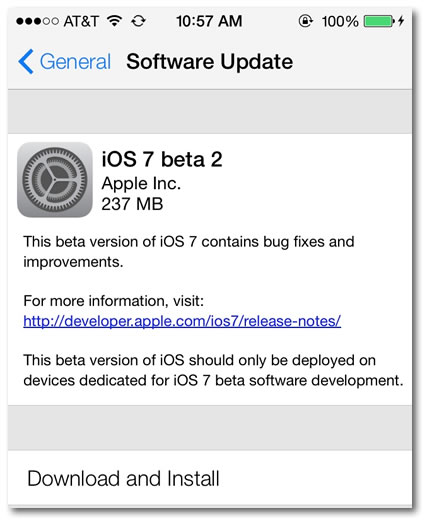
Tap the Download and Install button to do just that, and follow the screen prompts.
Point your browser at the iOS Dev Center. If you’re properly registered in the iOS Developer Program, you should have the options of looking at resources for iOS 6.1 and iOS 7. Naturally, you should select iOS 7 SDK beta, after which the page should look like the screen capture below:

You can click on the Downloads link under the Resources for iOS 7 beta heading, or simply scroll down. Either way, you’ll end up in the same place, where you’ll see this:

Download the one that’s appropriate for your iDevice. I’ve included direct links to the available packages below:
The file that you’re downloading is a disk image. Double-click it to mount the image. You should see one file that looks something like this:
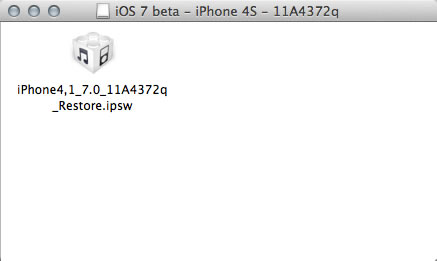
Connect your iDevice via USB to your Mac and start up iTunes. Let the sync complete. Click the iPhone or iPad button near the upper right-hand corner of the iTunes window:

The iTunes window should look something like this:
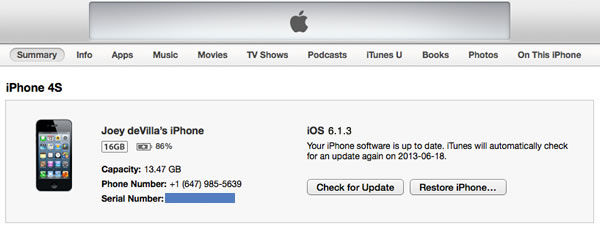
If you haven’t done so already, back up your iPhone.
And now, the important part of the process. I’m going to spell this out in large text:
While holding down the option or alt key on your keyboard, click the Restore iPhone… button. This allows you to choose a specific file to use when restoring your iPhone or iPod Touch. Choose the .ipsw file contained within the disk image you just mounted.
(That’s how you get iOS 7 on your iPhone or iPod Touch at this early point in the game: you’re restoring it from an image that has iOS 7 on it.)
Once you’ve done that, the uploading and installing process will take about 10 to 15 minutes. Your iPhone or iPod Touch will reboot once or twice during this time.
If you want to develop for iOS 7 Beta 2, you’ll need the latest version of Xcode 5 and the iOS 7 Beta 2 SDK. Here’s how you get it:
Point your browser at the iOS Dev Center. If you’re properly registered in the iOS Developer Program, you should have the options of looking at resources for iOS 6.1 and iOS 7. Naturally, you should select iOS 7 SDK beta, after which the page should look like the screen capture below:

You can click on the Downloads link under the Resources for iOS 7 beta heading, or simply scroll down. Either way, you’ll end up in the same place, where you’ll see this:

Click the Xcode 5 and iOS 7 SDK beta 2 link to start the download. It’s a .dmg file that’s about 1.7 GB in size, and when double-clicked, mounts a disk image and opens the window shown in the screen capture below:

It’s a straight-forward drag-the-app-to-the-Applications-folder-alias install, and you’re done!
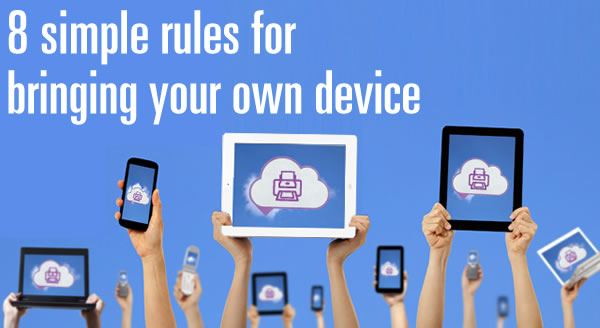
Cisco have come up with a term called “Comprehensive BYOD” as well as the eight things it comprises, and the idea’s so good that we’re going to borrow it. We’ve taken their eight points — they called them “foundational capabilities” — improved on them with a little re-ordering, re-wording and a jauntier name because we think that doing so makes them more effective. Here are our 8 Simple Rules for Bringing Your Own Device, or what organizations implementing BYOD need to do:
Through the strategic and judicious use of mobile device management (MDM), container applications, back office integration, and good practices and policies, you can follow the 8 Simple Rules, give your company’s employees the ability to use the devices they know and love, and get the most out of your BYOD program.
According to Cisco’s survey of 2,415 mobile users in 6 countries (Brazil, China, Germany, India, United Kingdom, and United States), as much as $3,150 per employee can be saved through “Comprehensive BYOD”. Cisco says that under a Comprehensive BYOD plan, employees will spend an average of $965 on their devices, plus another $734 in annual data plans, or a total of $1699 that they no longer have to spend since they’ve offloaded that cost onto their employees.
We beg to differ with Cisco. While there are some cost savings that can come from BYOD, we feel that employers should help employees cover the costs of work-related use of their devices through stipends or some other compensation plan. In our opinion, the really big wins that come from BYOD are employee productivity (up to 81 minutes of time saved every week, for every employee, according to Cisco’s survey) and satisfaction.
 In the previous article in this series, I showed you how to get the Xcode 5 preview and the iOS beta SDK up and running on your Mac. That enables you to start writing apps and testing them out on the Simulator.
In the previous article in this series, I showed you how to get the Xcode 5 preview and the iOS beta SDK up and running on your Mac. That enables you to start writing apps and testing them out on the Simulator.
Of course, it’s one thing to test an app on the Simulator, and it’s another thing to test it on a real iDevice. Running iOS 7 on your device lets you try out your apps in a closer-to-real-world situation, and it also lets you get a better feel for what the new version of the OS looks and feels like. Let’s face it, if you’re going to be developing apps for iOS 7, you’ve got to experience it on a regular basis, so that the apps you write look, feel, and function as though they belong.
Currently, the iOS 7 beta works only on:
You’re going to have to wait if you want to run iOS 7 on an iPad.

iOS 7, in its current state is not something for everyone to try. It’s a work in progress that’s being given exposure to developers, designers, and other people in the business of making iOS apps a much-needed advance trial. Since it’s still in development, not all the features are final, it hasn’t yet been fully optimized, and there’s no guarantee that all the known issues have been fixed. A lot of its features may still be subject to change, and any material on it that wasn’t released to the general public by Apple is covered by an NDA (non-disclosure agreement).
The question you must ask yourself is: “Am I a person in the business (or planning to be in the business) of making iOS apps?”
If the answer is “yes”, carry on. If the answer is “no”, and you just want a sneak peek, I suggest waiting.
You should make sure that you can answer yes to all the following questions:
Point your browser at the iOS Dev Center. If you’re properly registered in the iOS Developer Program, you should have the options of looking at resources for iOS 6.1 and iOS 7. Naturally, you should select iOS 7 SDK beta, after which the page should look like the screen capture below:
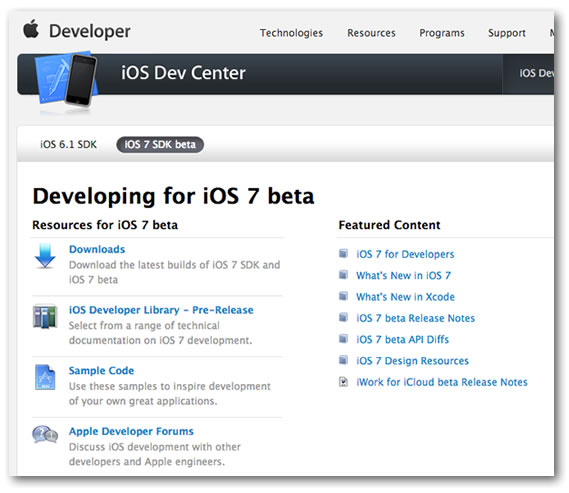
You can click on the Downloads link under the Resources for iOS 7 beta heading, or simply scroll down. Either way, you’ll end up in the same place, where you’ll see this:
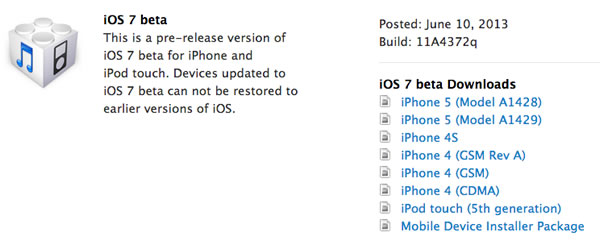
Download the one that’s appropriate for your phone. I’ve included direct links to the currently available packages below:
The file size might vary from model to model; mine was 1.16 GB.
The file that you’re downloading is a disk image. Double-click it to mount the image. You should see one file:

Connect your iPhone or iPod Touch via USB to your Mac and start up iTunes. Let the sync complete. Click the iPhone button near the upper right-hand corner of the iTunes window:

The iTunes window should look something like this:

If you haven’t done so already, back up your iPhone.
And now, the important part of the process. I’m going to spell this out in large text:
While holding down the option or alt key on your keyboard, click the Restore iPhone… button. This allows you to choose a specific file to use when restoring your iPhone or iPod Touch. Choose the .ipsw file contained within the disk image you just mounted.
(That’s how you get iOS 7 on your iPhone or iPod Touch at this early point in the game: you’re restoring it from an image that has iOS 7 on it.)
Once you’ve done that, the uploading and installing process will take about 10 to 15 minutes. Your iPhone or iPod Touch will reboot once or twice during this time.
Since most discussion of iOS 7 is still under non-disclosure agreement — you can talk about it all you want within the forums inside Apple’s developer site, but not out in public just yet — the best way to show you iOS 7 development is through showing you iOS 6 development. Until the embargo on showing iOS 7 in action is lifted, I’ll show you iOS 6 development, most of which is applicable to developing for iOS 7.
In order to do iOS 6 development, you’ll need the current version of Xcode, version 4.6.3 at the time of this writing. Getting the current version of Xcode is easy: you get it via the Mac App Store, and it’s free-as-in-beer. As I mentioned in the previous article, the current version of Xcode and the Xcode 5 beta can coexist on the same machine. In our explorations of iOS 7 development, I’ll show you iOS 6 code, which you can first try on the current Xcode, and then try out on Xcode 5.

No matter what your angle on mobile technologies is — mobile developer, a mobile IT pro, a mobile marketer, or participating in mobile ecommerce — you’re going to want to get a look at a slide deck titled Mobile is Eating the World. Yes, it’s another “state of the mobile industry” presentation saying that the future of mobile is massive, but it tells the story very well using mostly graphs, and it’s quite layperson-friendly. The presentation, put together by Enders Analysis consultant Benedict Evans, has gone unnoticed by the mobile tech world for almost a month because it wasn’t given at a tech event, but at BookExpo America, a book publishing industry conference.
I’ve taken the graphs from the slide deck and rearranged them a little; I think the story’s even stronger when the slides are in this order.
According to IDC, PC shipments are expected to drop by nearly 8% this year. They’re still selling, but the sales trend is no longer upwards, as the roles it once played exclusively are now being taken up by smartphones and tablets. A new version of Windows used to boost PC sales, but that’s no longer the case; a number of people in the industry say that it’s the upcoming end of extended support for Windows XP (this happens on April 8, 2014) rather than Windows 8 that will slow the decline:
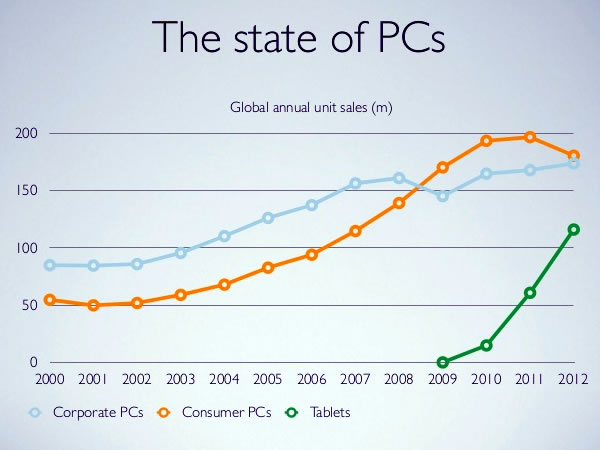
At the same time, sales of smartphones are booming. They’ve got much faster product cycles, and people tend to replace them every 2 or so years on average, rather than every 4 years with PCs:

CCS Insight predicts that 1.86 billion phones will be shipped in 2013, and 53% of them will be smartphones. In fact, more smartphones than non-smartphones were shipped for the first time in the first quarter of 2013:
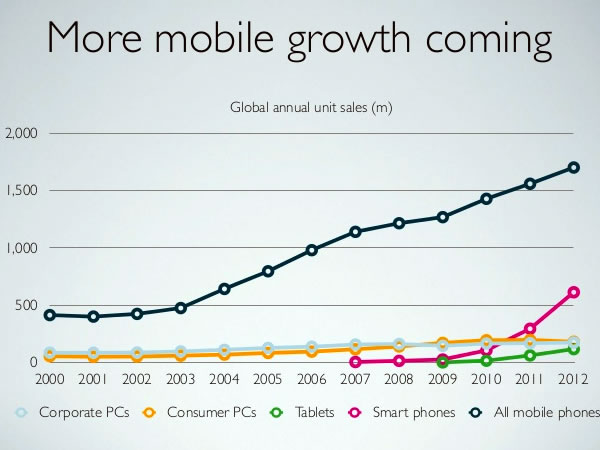
According to Evans’ charts, tablet sales surpassed desktop PC sales in late 2012 and are quite close to laptop sales today. It shouldn’t be surprising to find that 1 in 3 American adults owns a tablet:
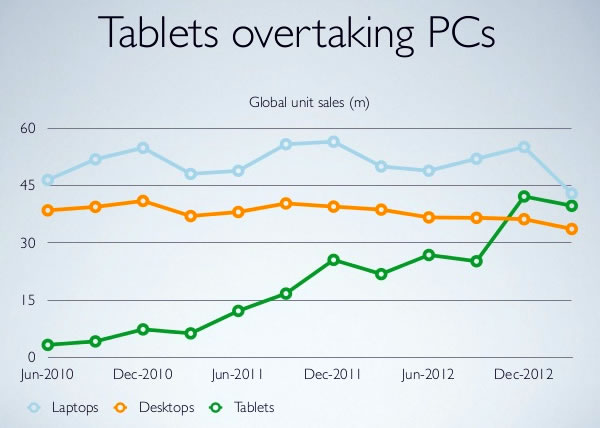
If you treat Android, Kindle Fire and Nexus tablets as individual platforms — and from a non-technical end user’s point of view, they are individual platforms — then the tablet market resembles the PC market in the mid-1980s, with a couple of big players and some smaller but significant ones:

In G8 countries, the phrase “tablet market” might as well be synonymous with “iPad market”:
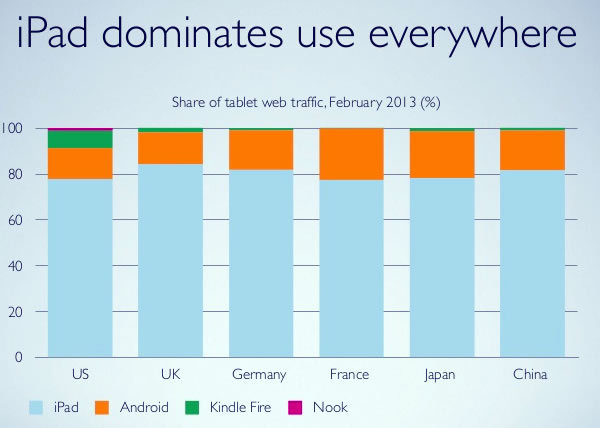
One casualty of the rise of tablets is the ereader. While they’re cheaper and typically have better battery life than tablets, the fact that they’re single-taskers, have a form factor that’s all-too-similar to tablets, and cost almost as much as the new smaller tablets (such as the iPad Mini) make them less appealing to purchase. They will most likely turn out to be a transitional technology, as netbooks and PDAs were:
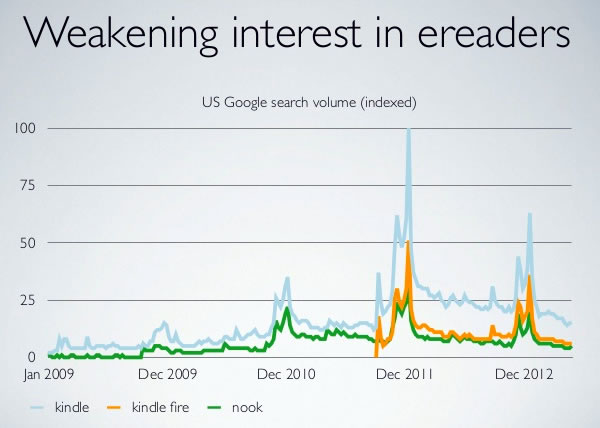
Mobile is booming:
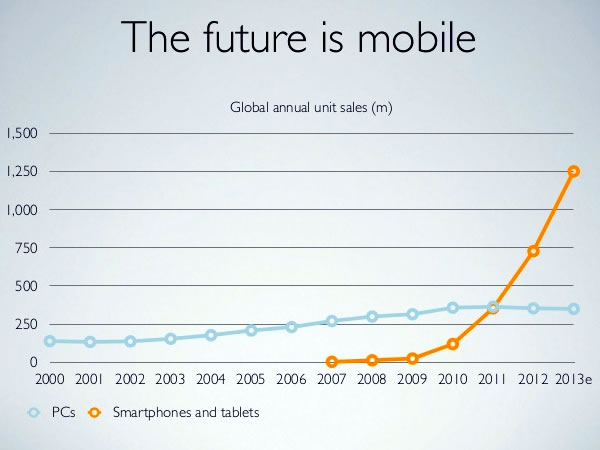
In fact, it’s expected that there will be more mobile phones than people by 2017:
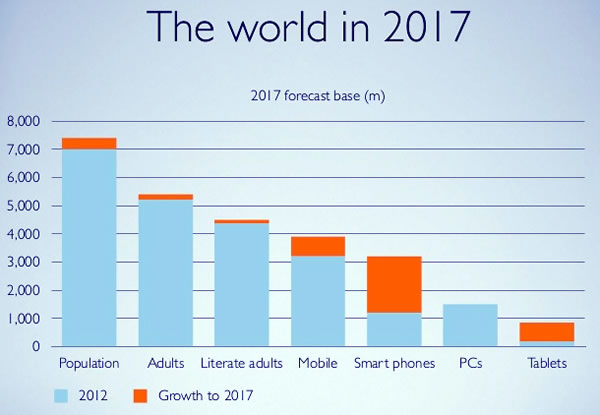
Two big players dominate, each with different audiences, own the mobile market. Samsung sells the most mobile units, but Apple has the most active users, with former heavyweights BlackBerry and Microsoft clawing tooth and nail for a distant third place:
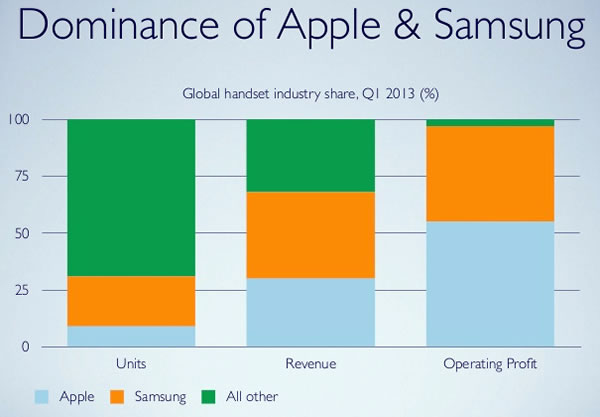
Ouch:

Back in 1994, when I was about to graduate with my computer science degree, I was at first intrigued by an ad place in some programming newsgroups about a company that was planning to sell stuff through an online catalog and deliver their products via courier or standard shipping. In the end, I dismissed it thinking “Really? That’s just the old Sears & Roebuck mail order catalog in electronic form.” I’m kicking myself now:

Like me, Evans compared Amazon to Sears & Roebuck — just not dismissively:
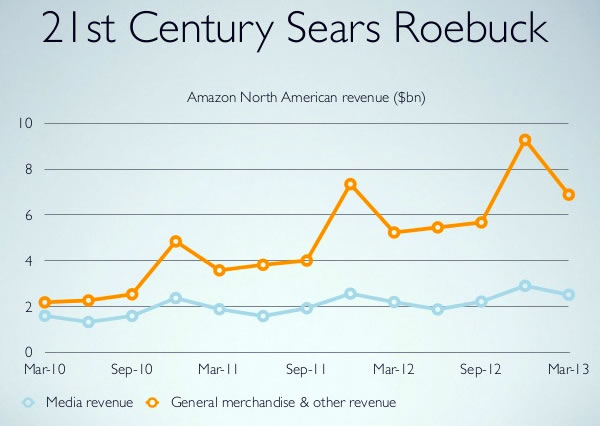
And having seen Amazon’s sales and having worked at Shopify, I’ve witnessed the upward trend in this chart from the front lines:
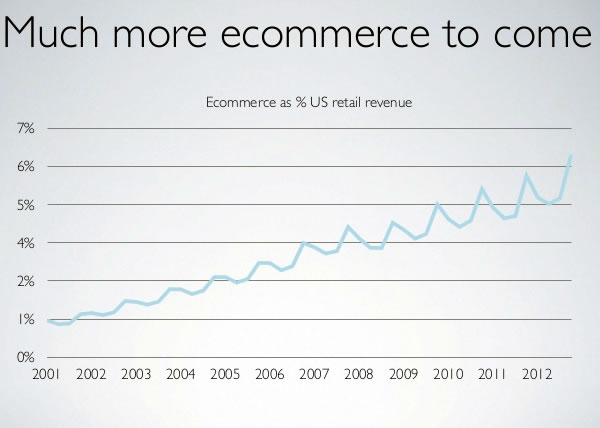
Be sure to check out the full slide deck of Mobile is Eating the World. It’s a mere 24 slides, but it’s great fodder for those of you who need material on the state of the industry:
 As I mentioned in my previous article, iOS 7 represents more than a change in Apple’s approach to their mobile device user interfaces; it also represents an opportunity for developers who’ve been putting off learning how to build native iOS apps to get started. iOS 7 is the latest in a series of changes that makes the present time the best time for a new developer to try their hand at making apps for the iPhone, iPad and iPod Touch, which include:
As I mentioned in my previous article, iOS 7 represents more than a change in Apple’s approach to their mobile device user interfaces; it also represents an opportunity for developers who’ve been putting off learning how to build native iOS apps to get started. iOS 7 is the latest in a series of changes that makes the present time the best time for a new developer to try their hand at making apps for the iPhone, iPad and iPod Touch, which include:
This is only the start of the first wave of products that come after the era of Steve Jobs (the tastemaker) and Scott-Forstall (the technologist), who both brought their own set of design and technology decisions to iOS. Jony Ive, who’s been responsible for Apple’s brilliant chassis designs, is now doing overall design, which includes user interfaces. On the technology side, Craig “Hair Force One” Federighi’s role has expended from just Mac OS to include iOS. While both the old and new guard seem to follow the Apple credo of “a thousand no’s for every yes”, Ive’s and Federighi’s decisions will likely be quite different from those that Jobs and Forstall would’ve made.
One of the reasons many people stay away from native iOS app development is that it looks hard. It didn’t help that iOS development required two separate applications, Xcode for code writing and Interface Builder for laying out and setting up user interfaces. Interface Builder is now built into Xcode, and this new, unified application has been refined so that it seems odd to think that they were once separate programs. At the same time, the Objective-C programming language and compiler have undergone a fair amount of modernization. If you have some experience with any currently popular object-oriented programming language, whether it’s C#, Java, JavaScript, PHP, Python, Ruby or Visual Basic, you shouldn’t have too much difficulty making the leap to Objective-C.
Before the iPhone’s introduction in 2007, smartphone interaction took place on a physical keyboard, with a trackball, stylus, or wheel acting as a secondary pointing device. iOS veered away from this familiar interface and made the touchscreen the primary input device. This new touch-based interface needed controls that clearly gave away their purpose, and this led to making them look like their physical counterparts: push buttons, toggle switches, dials, and so on. Six years have passed since the introduction of the iPhone, and most mobile devices use the touchscreen as their primary interface. While iOS’s user interface made sense in the world of 2007, in 2013, iOS’ user interface can cast off the “training wheels” it provided to users.
All these changes, taken together, mean that you can approach iOS it as if it were a completely new platform — one that just happens to have a large (and the most active) user base. This “perfect storm” of changes doesn’t happen often — perhaps once a decade — so if you’ve been putting learning iPhone and iPad native app development for “the right moment”, I have news for you: that right moment is now.
You can get the tools for the current version of iOS simply by being enrolled in Apple’s free developer program, but in order to get an early developer look at iOS 7, you need to be registered in the iOS Developer Program. It’s only US$99 a year for individual developers, and it gives you access to all the advance information about iOS 7, as well as the ability to submit your apps for sale in the App Store. The sign-up process is fairly quick, and you can start it at Apple’s iOS Developer Program enrollment page.
Once you’re enrolled, you can start downloading the development tools and iOS 7 for your iDevice, as well as access the resources that they’ve made available to developers.
![]() In order to build iOS 7 apps, you’ll need the Preview version of Xcode 5, the next version of Apple’s IDE. It comes with the iOS 7 beta SDK, which includes the iOS Simulator, which lets you test your apps before deploying them to a real device (or try them out if you don’t have an iPhone, iPad or iPod Touch handy). It has a different name from the current version of Xcode (the current version is Xcode, the preview is called Xcode5-DP), and both versions can be on the same Mac at the same time.
In order to build iOS 7 apps, you’ll need the Preview version of Xcode 5, the next version of Apple’s IDE. It comes with the iOS 7 beta SDK, which includes the iOS Simulator, which lets you test your apps before deploying them to a real device (or try them out if you don’t have an iPhone, iPad or iPod Touch handy). It has a different name from the current version of Xcode (the current version is Xcode, the preview is called Xcode5-DP), and both versions can be on the same Mac at the same time.
Normally, you would simply get Xcode by downloading it for free from the Mac App Store. However, Xcode 5 is a preview and has not yet been released; you have to download it from the Apple Developer site.
Point your browser at the iOS Dev Center. If you’re properly registered in the iOS Developer Program, you should have the options of looking at resources for iOS 6.1 and iOS 7. Naturally, you should select iOS 7 SDK beta, after the page should look like the screen capture below:
You can click on the Downloads link under the Resources for iOS 7 beta heading, or simply scroll down. Either way, you’ll end up in the same place, where you’ll see this:
 Click the Xcode 5 and iOS 7 SDK beta link to start the download. It’s a .dmg file that’s 1.73 GB in size, and when double-clicked, mounts a disk image and opens the window shown in the screen capture below:
Click the Xcode 5 and iOS 7 SDK beta link to start the download. It’s a .dmg file that’s 1.73 GB in size, and when double-clicked, mounts a disk image and opens the window shown in the screen capture below:

It’s a straight-forward drag-the-app-to-the-Applications-folder-alias install, and you’re done!